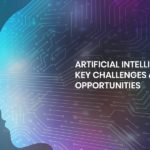A chatterbot or ‘chatbot’ is an artificial intelligence (AI) program that can simulate a real interaction — spoken, written or both, via chat interface. By leveraging machine learning (ML) and natural language processing (NLP), AI-powered chatbots can identify the user’s underlying intent and respond in a natural, human way. It can learn from past conversations and improve its ability to provide appropriate responses and solutions.
These intelligent conversational agents can be found everywhere, ranging from virtual assistants like Siri and Alexa, messaging applications, business websites, to our favorite online e-commerce store. A myriad of businesses are investing in chatbots and AI technology to deliver better customer experience and get better ROI results.
As per a report, Gartner predicted that 70% of white-collar workers will interact with conversational platforms on a daily basis by 2022. Chatbots are surpassing the functionality of interactive voice response systems, which simply help users progress through a decision tree of potential options.
Artificial Intelligence components used in chatbot
AI uses two important elements that help the bot to strike accurate response:
Machine Learning: ML is an algorithm that helps the bot to learn from queries and the data fed during bot training. When a query is triggered, ML aids the bot to first monitor the past conversation it had with the user and give a response accordingly.
Natural Language Processing: NLP works with ‘intent’ and ‘entity’. It provides assistance to the bot to understand and interpret the information or the intent closely. Entities help to train the bot to recognize specific phrases from the queries. When an entity is mapped to intents, the bot is able to detect a phrase whenever it encounters similar query.
How Artificial Intelligence empowers chatbot?
Rather than being confined by a series of possible paths, AI bots can generate relevant, contextually informed responses to a variety of prompts.
These bots are used widely in domains such as e-commerce, banking, research, finance, sales, marketing and many more. They’re a good fit for business functions that have historically involved people performing time-consuming, repetitive tasks, such as handling customer services, taking orders and complaints, and are likely to improve efficiency and standardization of functions and services.
Technology and chatbot architecture
NLP is the heart of AI-driven bots and so is the chatbot architecture to its development. Using integrated NLP services, developers can build their tools and platforms that make chatbot apps language-intelligent.
Chatbots work on pattern-recognition and a set of algorithms. Main components of bot architecture are:
- Environment: This is where the core NLP engine and context interpretation comes in picture and it involves:
- Natural Language Understanding: NLU is an understanding of the textual and statistical data captured by computers. It mainly consists of intent classifier and entity extractor.
- Dialogue Manager: DM manages the actual context of a dialogue, enabling bots to virtually handle all the nuances related to human conversations, including interruptions, clarifications and more. This is handled by various plugins.
- Natural Language Generation: NLG analyzes and converts dataset into legible narratives understood by humans.
To make the message logical for a bot, NLP has following main elements:
- Lexical analysis: It includes words structure identification and analysis and divides the text into sentences, phrases, and words.
- Syntactic analysis: It involves analyzing grammar and arranging words, so the relationships among words become clear. For instance, it will reject “hot ice-cream” in a sentence.
- Semantic analysis: It checks the text for meaningfulness and draws its exact meaning by mapping syntactic constructions. The phrase such as “cold fire” would be disregarded.
- Discourse integration: It deals with the analysis of structure and meaning of text beyond a single sentence, making connections between words and sentences.
- Pragmatic analysis: It deals with use of real-world knowledge that is external to the documents and/or queries.
- Question and Answer System: It focuses on building systems that automatically answer questions posed by humans in a natural language.
- Plugins/Components: Plugins offer chatbots solution APIs and other intelligent automation components for chatbots used for internal company use like HR management chatbots.
- Node Server: This handles the traffic requests from users and routes them to appropriate components. The traffic server also routes the response from internal components back to the front-end systems.
- Front-end Systems: These are the client facing platforms for which the bots work.
Advantages of Artificial Intelligence enabled chatbot
Unlike humans, some restrictions do not exist for chatbots. The main advantages of an AI bot can be summarized as:
- Reduced costs and turn-around time
- 24/7 availability with pre-emptive support
- Broader handling capacity
- Improved customer satisfaction
- Sentiment Analysis
- Consumer data monitoring and deeper insights
- Consistent and registered responses
- Inexhaustible behavior and patience
- Programmability and repetitive task automation
For more information about AI and NLP at DaasLabs click here: https://daaslabs.ai/services/NLP.html




